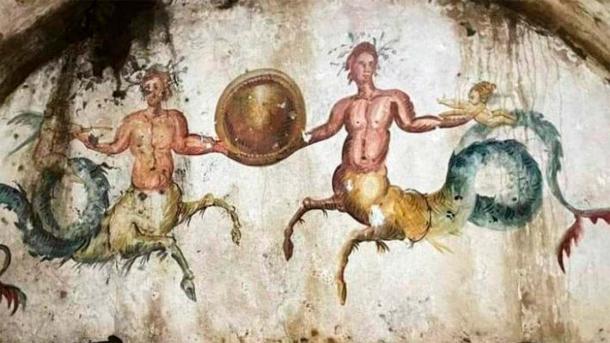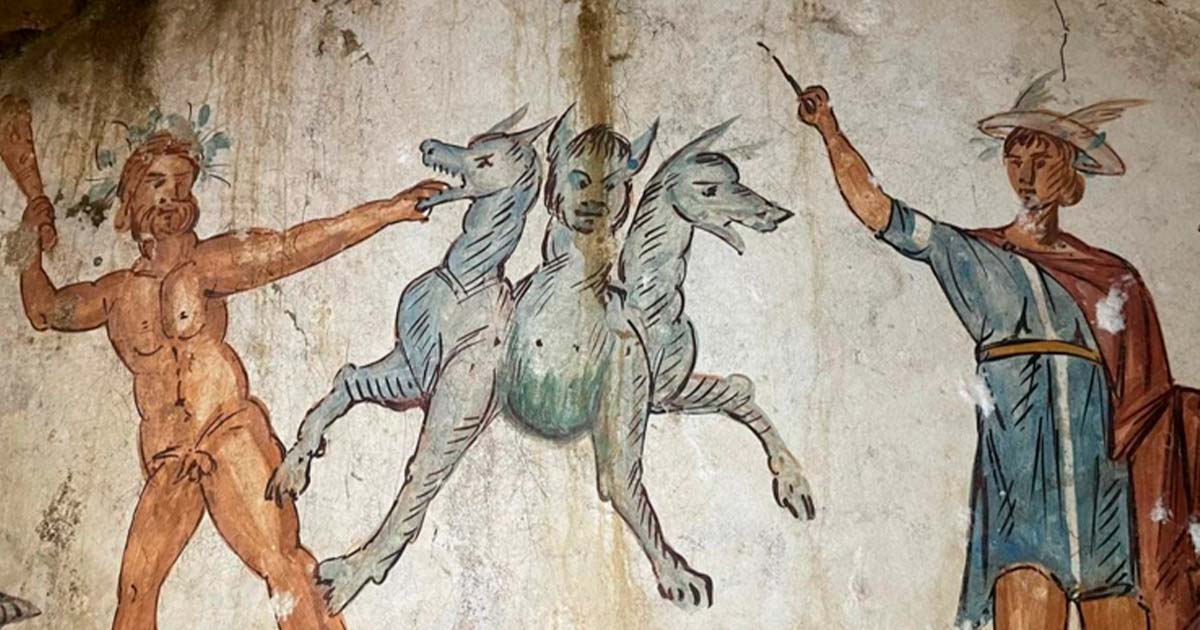Unearthed 'Tomb of Cerberus' Features Pristine Frescoes from Ancient Roman Era
In a historic revelation, archaeologists have discovered a sealed chamber tomb featuring a captivating fresco of Cerberus, the renowned three-headed dog from Ancient Greek mythology said to guard the gates of the underworld. Located in the suburb of Giugliano near Naples, the tomb, estimated to be around 2,000 years old, was unearthed during an archaeological survey ahead of maintenance work on the city's water system.
The burial chamber was brought to light after archaeologists identified a wall constructed using the ancient Roman method known as opus incertum. Initially, the wall was thought to mark the boundary of a necropolis, but it turned out to be the frontal wall of the chamber tomb, which was meticulously sealed with a slab of tuff, a lightweight, porous rock formed from volcanic ash. To access the inner sanctum of the burial chamber, researchers carefully removed tiles covering the ceiling opening, unveiling what has been described by the Archaeological Superintendency of Naples as an "unprecedented" find.

Entrance to the chamber tomb discovered near Naples. (Soprintendenza Archeologia Belle Arti e Paesaggio per l’Area Metropolitana di Napoli)
Inside, the tomb boasts frescoes in near-pristine condition, covering its ceilings and walls. Among the standout features are mythological scenes, including ichthyocentaurs—centaurine-type sea gods combining human, horse, and fish elements. A particularly riveting scene displays two ichthyocentaurs holding an ancient Greco-Roman shield, each with an erote, a winged Cupid-like baby symbolizing love and desire, perched on their arm.
- Hades, God of the Underworld and His Unsung Powers
- Overlords of the Underworlds: 10 Gods of Death From Around the World

Frescoes of Ichthyocentaurs also found in the chamber tomb. (Soprintendenza Archeologia Belle Arti e Paesaggio per l’Area Metropolitana di Napoli)
But it's the depiction of Cerberus that takes center stage. This vivid representation is an ode to the 12th and most perilous of Hercules' Labors: his descent into Hades, guided by Mercury, to capture the formidable three-headed beast.
Cerberus and the Underworld
In ancient Greek mythology, Cerberus is a fearsome three-headed dog guarding the entrance to Hades, the Underworld where spirits can enter but cannot leave. Representing a fusion of several creatures, Cerberus's appearance was inspired by the ancient Greeks' view of dogs as wild, undomesticated beings.
The name "Cerberus" derives from the Greek "Kerberos," translating to “spotted.” This "hell hound" possessed a serpent's tail, a mane made of snakes, lion's claws, and three heads symbolizing either the past, present, and future or birth, youth, and old age.
Cerberus's gaze was petrifying, literally turning onlookers to stone. He also had a venomous bite, with the poison creating the wolf’s bane plant. Cerberus's lineage was equally intimidating; his father was Typhon, the most powerful monster in Greek mythology, and his mother was Echidna, a half-woman, half-snake known as the "mother of all monsters" who lured and devoured men.
A Star Find Near Naples
Numerous burials from both the Roman Republic era (510-31 BC) and the Roman Imperial Age (31 BC – AD 476) have been found in this region previously. Yet, the Tomb of Cerberus stands out, not only for its impressive frescoes but also for its unparalleled state of preservation.
Mariano Nuzzo, the superintendent of Archaeology, Fine Arts, and Landscape for the Naples metropolitan area, was enthralled by the discovery. He commented:
"The tomb has frescoed ceilings and walls in impeccable condition, adorned with mythological scenes. The emotion triggered by such a discovery is indescribable. Giugliano is witnessing a reemergence, shedding light on significant relics of its illustrious history, warranting preservation and protection through collective efforts."
The Tomb of Cerberus will undoubtedly captivate historians, archaeologists, and enthusiasts around the world. As studies progress, there's hope that this discovery will shed more light on the life, beliefs, and artistic inclinations of the ancient Romans who once inhabited this region.
Top image: Fresco in Tomb of Cerberus discovered near Naples. Source: Soprintendenza Archeologia Belle Arti e Paesaggio per l’Area Metropolitana di Napoli
By Gary Manners

















